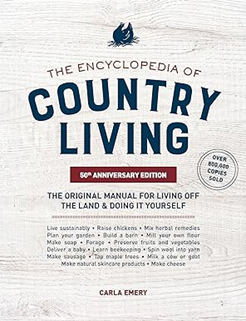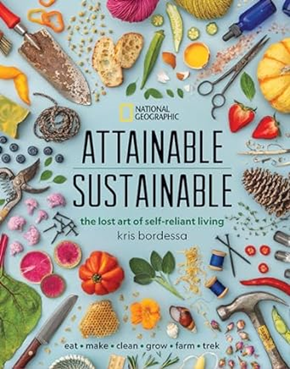12 Books Every Homesteader Should Have on Their Shelves
- Christine Simons
- Aug 28, 2024
- 7 min read
Updated: Jul 3
Some girls love jewelry.
Some love flowers.
But me? I love books.
My husband (also a book-lover) knows that the way to my heart is through my bookshelves. In light of this, he built me a custom, floor-to-ceiling bookshelf in our kitchen for my cookbooks and homesteading library. Today, I’m going to share with you my top picks (so far!) for the books that I think should be on every homesteader’s (particularly every busy-suburban-homesteader-on-a-budget’s) bookshelf.

Disclosure: This post contains affiliate links. Any purchases made through these links may result in commission payment to me, but this will not affect the price you are charged.
1. The Encyclopedia of County Living, 50th Anniversary Edition: The Original Manual for Living off the Land & Doing It Yourself by Carla Emery

This massive book is worth its weight in gold! Carla Emery covers a wide variety of homesteading subjects, but she also provides sufficient depth for each of them. Everything from raising and butchering livestock to making your own crafts is covered in this volume. She also provides leads to additional resources for further study or instruction. Its breadth and depth keep this book at the top of my homesteading library list.
2. Nourishing Traditions: The Cookbook that Challenges Politically Correct Nutrition and the Diet Dictocrats by Sally Fallon

This book, much like Emery’s, contains a wealth of knowledge, specifically regarding food and nutrition. In addition to providing recipes (like any other cookbook), this book delves into the health benefits of traditional foods and preservation methods and challenges the prevailing wisdom of the current dieticians.

I actually came across this one at a Half Price Books store, and it was a hidden gem! Wardeh Harmon systematically explains how fermenting works, and then she provides a list of step-by-step recipes for different types of fermentation, starting with the simplest to master and moving to the most complex. As I ventured beyond sourdough-baking and into home-fermenting other foods, I regularly consulted this resource to guide me on my fermentation journey.
4. New World Sourdough: Artisan Techniques for Creative Homemade Fermented Breads; With Recipes for Birote, Bagels, Pan de Coco, Beignets, and More by Bryan Ford

While this book definitely covers a niche subject, it provides practical, step-by-step guides for baking a variety of breads with sourdough starter. For the novice baker (or even the experienced baker looking to try something new!), its clear directions and beautiful photo illustrations make this book a treasure.
5. All New Square Foot Gardening , 3rd Edition, Fully Updated: MORE Projects - NEW Solutions - GROW Vegetables Anywhere (Volume 9) by Mel Bartholomew

For homesteaders with limited space—especially in the city or suburbs!—this book is a must. Mel Bartholomew explains how to set up a square-foot grid for your garden to reduce space and maximize your harvest. Bartholomew’s method is so successful—and has become so popular—that he’s had to update his book several times. But even if you find an older copy, you’ll find a treasure trove of information. Not only does his method condense a garden into a reasonable space, but it improves the gardener’s efficiency and reduces their workload (and price tag). It’s a win-win!
6. Lasagna Gardening: A New Layering System for Bountiful Gardens: No Digging, No Tilling, No Weeding, No Kidding! by Patricia Lanza

This book is another must for homesteaders with limited time or resources. Rather than spending hundreds of dollars on raised beds and gardening soil, consider taking the time to slowly build up your soil through the lasagna method. Lanza offers practical methods and advice to create beautiful, lush gardens without sacrificing tons of time, energy, or money.
7. The Backyard Homestead: Produce All the Food You Need on Just a Quarter Acre! edited by Carleen Madigan

This book covers a variety of topics. However, it’s quite focused on the topics it covers, going into quite a bit of depth, and offers step-by-step guides (with illustrations!) for the backyard-homestead beginner. The gardening section in particular covers many different crops and provides guides for planting in specific zones. It doesn’t cover nearly as much as Emery’s book, but it’s still a solid read for a beginner, especially one in a “small” space (less than an acre). Even if you’re a city dweller, you’ll find helpful advice and guidance here.

No list of homesteading books for busy suburbanites on a budget would be complete without this gem. This one is focused pretty specifically on gardening for busy suburbanites, but it does so with clarity and practicality. In this book, Amy Stross shares her experience, becoming your garden guide and cheerleader. She outlines step-by-step, month-by-month tasks that even busy people can accomplish, taking the guesswork out of gardening and making it manageable. As someone who tends to “go big or go home,” I appreciate her sensible advice and bite-sized garden management tasks.
9. The Homesteader’s Herbal Companion: The Ultimate Guide to Growing, Preserving, and Using Herbs by Amy K. Fewell

This one provides all that’s promised in its subtitle. In addition to covering different types of herbs and how to grow them, Amy K. Fewell teaches you how to actually use them to maximize their health benefits. She provides various recipes for herbal medicines and discusses safe and appropriate use for them. If you have (or would like to have!) an herb garden, this book is for you.
10. The Resilient Farm and Homestead: An Innovative Permaculture and Whole Systems Design Approach by Ben Falk

This book takes a more holistic approach to homesteading and living self-sufficiently. It presents a dive-in-feet-first approach to building your homestead from the ground up while keeping natural processes and cycles in mind. Ben Falk takes an academic approach to permaculture, and his book packs a ton of information into a medium-sized space. But don’t be intimidated! Falk’s principles can be applied to just about any homestead.
Full disclosure: I haven’t actually finished reading this one yet. Because it’s such a rich, academic text, I find myself soaking in the information a little bit at a time. But it’s one I can keep coming back to—and do keep coming back to—when I need it.
(Note: I found this one at a reasonable price at Half Price Books. It may be more expensive when purchased through other sellers, such as Amazon or ThriftBooks.)
11. Go Green, Save Green: A Simple Guide to Saving Time, Money, and God's Green Earth by Nancy Sleeth

Another Half Price Books gem on my bookshelf, this book offers practical steps for saving money while also being mindful of the environment. It’s the only book I’ve come across (so far!) that is offers such down-to-earth (pun totally intended) advice from a Christian perspective. While I may not agree with Sleeth’s dire assessment of the earth’s current state, the money-saving tips and tricks she lists are a no-brainer for the modern suburban homesteader on a budget.
12. The Forager’s Guide to Wild Foods: Edible Plants, Mushrooms, Lichens, and Seaweeds by Dr. Nicole Apelian

While a little on the pricy side, this beautiful book contains hundreds of lovely colored photos and includes a wealth of information on wild edibles in North America, including dangerous lookalikes and distribution maps. If foraging is something you’d like to do (or are doing already), this resource is incredibly handy and potentially life-saving. (As a side note, please do not consume any wild or foraged foods unless you are 100% sure you have identified them correctly. If you are unsure of a wild plant’s identity, better safe than sorry!)
Bonus Books!
14. Little House in the Suburbs: Backyard Farming and Home Skills for Self-Sufficient Living by Deanna Caswell and Daisy Siskins


So, these two are books I would consider “Homesteading Lite.” Both of them scratch the surface of self-sufficient living and cover a broad variety of topics without going into significant depth. In fact, Emery’s Encyclopedia of Country Living covers everything in these books and more, so these two are redundancies. However, they are both great primers for the beginning homesteader, especially the busy suburban homesteader on a budget. They present an introduction to self-sufficient living without overwhelming the reader. As an added bonus, their eye-catching designs make them a pleasure to peruse.
15. The Anxiety Cure: A Proven Method for Dealing with Worry, Stress, and Panic Attacks by Dr. Archibald Hart

This one isn’t actually a homesteading book, but it’s one I cannot recommend highly enough! Dr. Hart’s approach to modern anxiety goes hand-in-hand with the mindfulness inherent in homesteading. Dr. Hart approaches anxiety from a Christian perspective, but even if you’re not religious, don’t let that stop you from picking up this treasure! He explains in clear and simple terms how modern society—with its fast pace and constant stimuli—has affected our mental health and how to reorganize your life to reclaim peace of mind.
(I actually studied psychology as my undergraduate minor, and I still learned a lot from this book. Dr. Hart taught me more about dealing with anxiety and depression than all of my college courses put together, and he did it using layman’s terms.)
On another note, this book is usually cheaper when purchased (lightly used) through ThriftBooks.com rather than Amazon. If you choose to purchase through ThriftBooks rather than through my Amazon-affiliated link, I won't earn commission on your purchase; still, I'd like you to know so that you can get the most use out of your dollar.
***
So there you have it—twelve books (really, fifteen) that I think should be on every homesteader’s bookshelf.
Do you have another book you think should be included? Or have you read any of the books on my list and you want to share your thoughts? Drop a note in the comments!






Comments